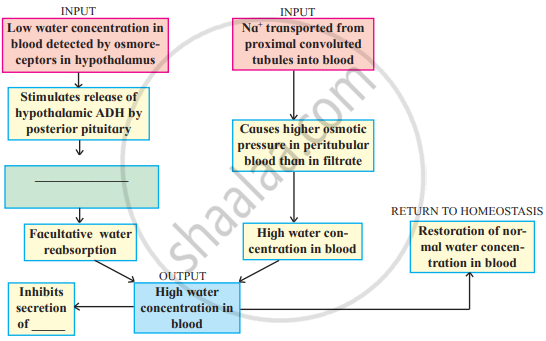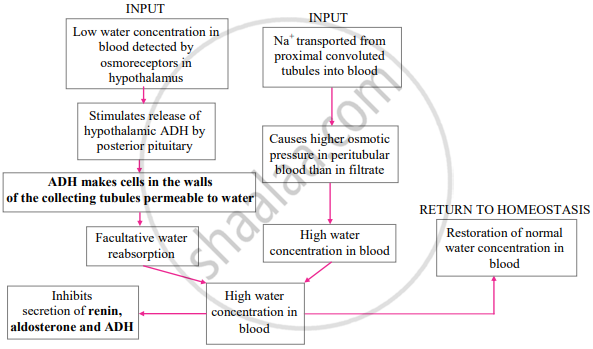Advertisements
Advertisements
Question
Complete the diagram/chart with correct labels/ information. Write the conceptual details regarding it.

Solution

The composition of urine depends upon food and fluid consumed by an individual. There are two ways in which it the composition is regulated. They are as follows:
- Regulating water reabsorption through ADH:
Hypothalamus in the midbrain has special receptors called osmoreceptors which can detect a change in osmolarity (measure of a total number of dissolved particles per liter of solution) of blood. If osmolarity of blood increases due to water loss from the body (after eating namkeen or due to sweating), osmoreceptors trigger the release of Antidiuretic hormone (ADH) from neurohypophysis (posterior pituitary). ADH stimulates reabsorption of water from the last part of DCT and the entire collecting duct by increasing the permeability of cells. This leads to a reduction in urine volume and a decrease in osmolarity of blood. Once the osmolarity of blood comes to normal, the activity of osmoreceptor cells decreases leading to a decrease in ADH secretion. This is called negative feedback. In case of hemorrhage or severe dehydration too, osmoreceptors stimulate ADH secretion. ADH is important in regulating water balance through the kidneys. In absence of ADH, diuresis (dilution of urine) takes place and person tends to excrete large amounts of dilute urine. This condition called diabetes insipidus. - Electrolyte reabsorption through RAAS:
Another regulatory mechanism is RAAS (Renin Angiotensin Aldosterone System) by Juxta Glomerular Apparatus (JGA). Whenever blood supply (due to change in blood pressure or blood volume) to afferent arteriole decreases (e.g. low BP/dehydration), JGA cells release Renin. Renin converts angiotensinogen secreted by hepatocytes in the liver to Angiotensin I. ‘Angiotensin-converting enzyme’ further modifies Angiotensin I to Angiotensin II, the active form of the hormone. It stimulates the adrenal cortex to release another hormone called aldosterone that stimulates DCT and collecting ducts to reabsorb more Na+ and water, thereby increasing blood volume and pressure. - Atrial natriuretic peptide (ANP):
A large increase in blood volume and pressure stimulates the atrial wall to produce atrial natriuretic peptide (ANP). ANP inhibits Na+ and Cl– reabsorption from collecting ducts inhibits the release of renin, reduces aldosterone and ADH release too. This leads to a condition called Natriuresis (increased excretion of Na+ in urine) and diuresis.
APPEARS IN
RELATED QUESTIONS
Why is it necessary to excrete waste products?
Draw a diagram of the human excretory system and label the various parts.
Fill in the blank.
Malpighian body consists of Bowman’s capsule and .....................
Fill in the blank.
....................... are present in the stem of pine tree that make the pinewood strong and durable.
In humans, urea is formed in
Differentiate between the following pairs of term :
Renal cortex and renal medulla
Give Technical Term:
The duct which transports urine from the kidney to the urinary bladder.
Write the functional activity of the following structure: Vasopressin
Write the functional activity of the following structure: Aldosterone
The habitat of animals that excrete nitrogenous waste in the form of urea.
